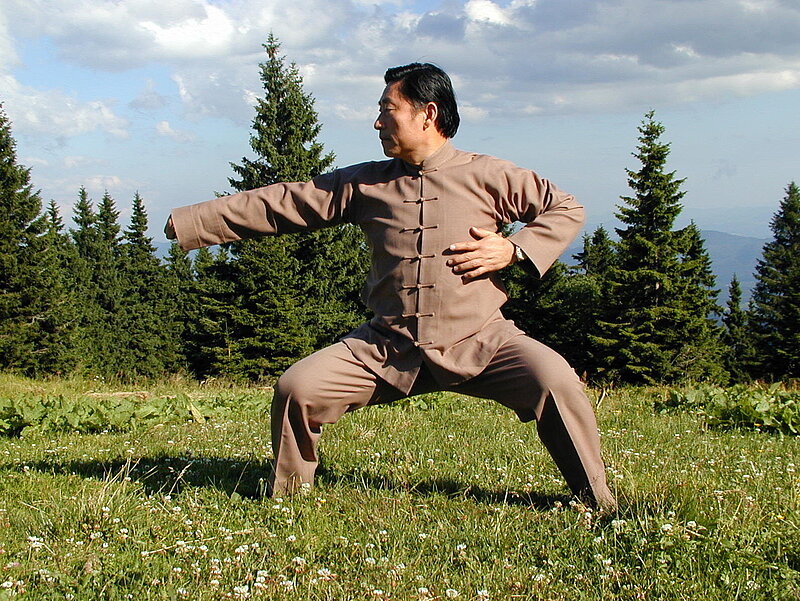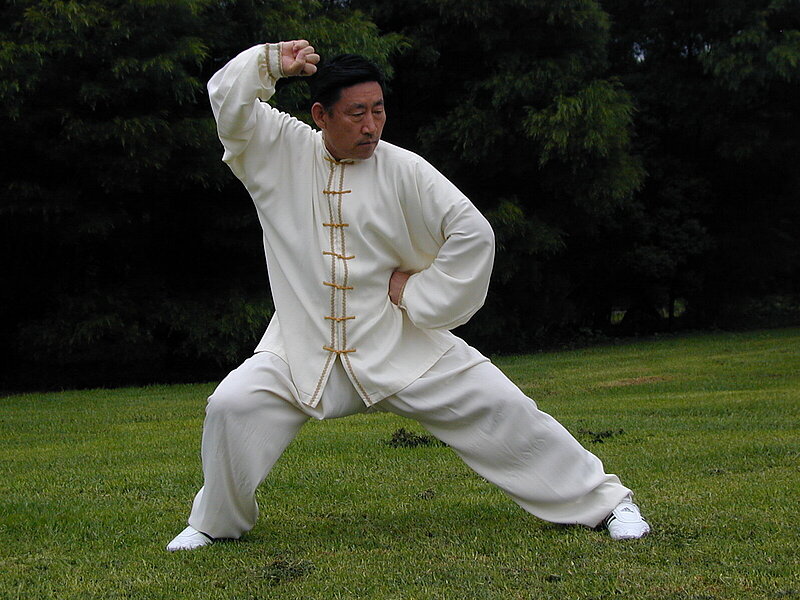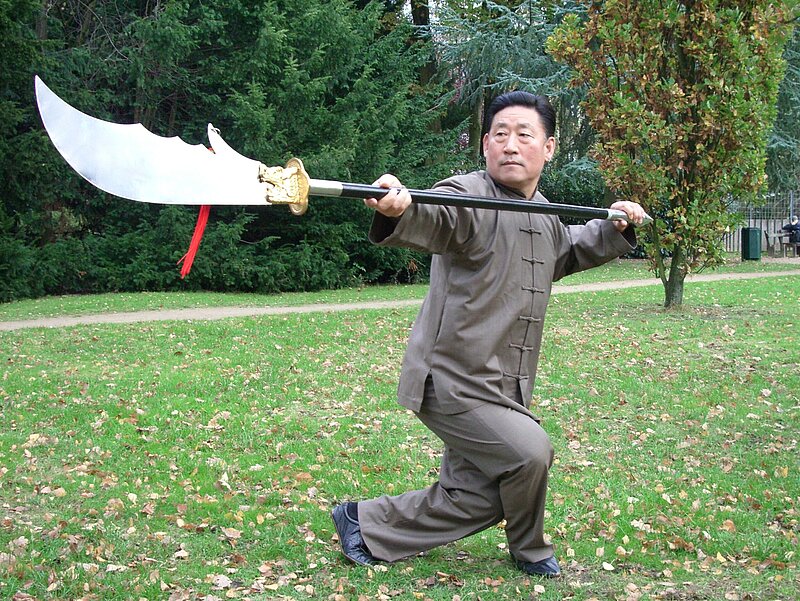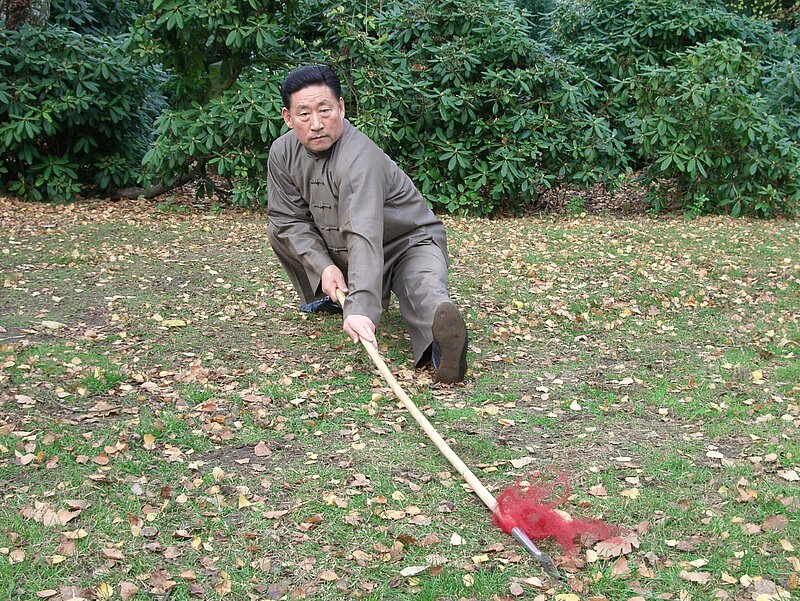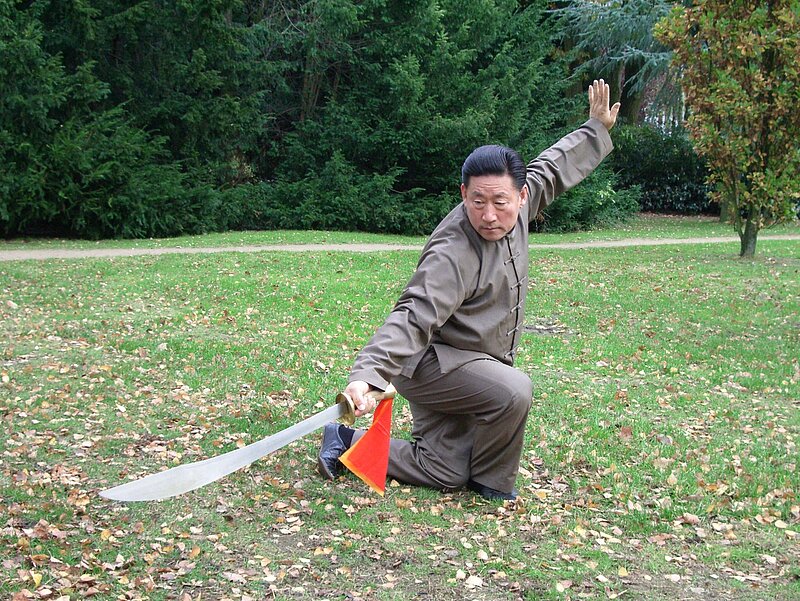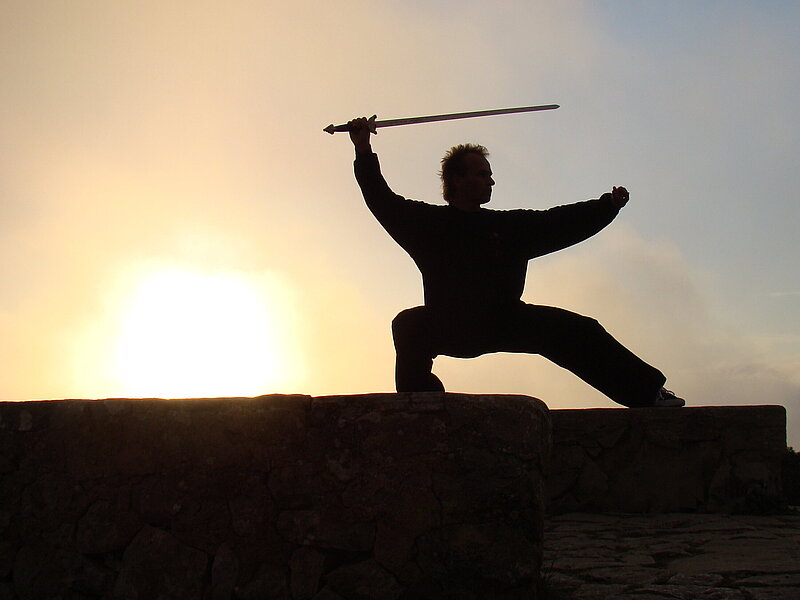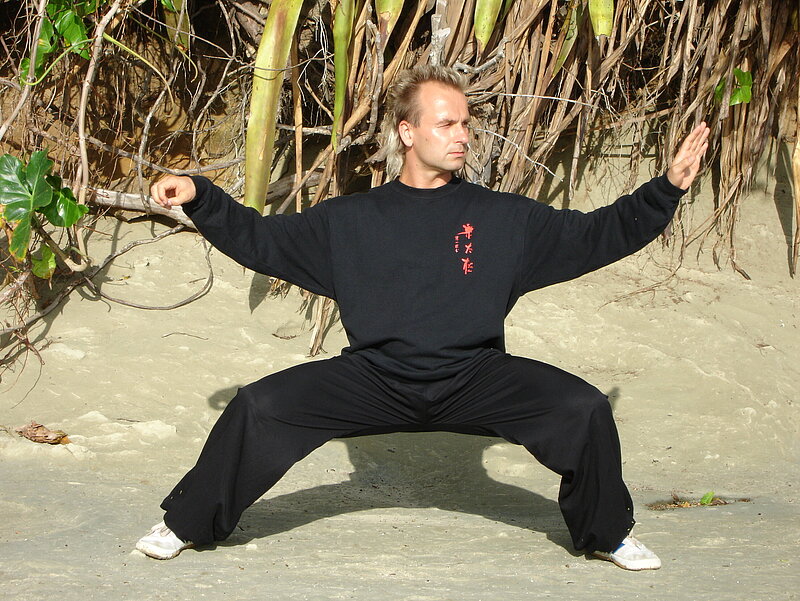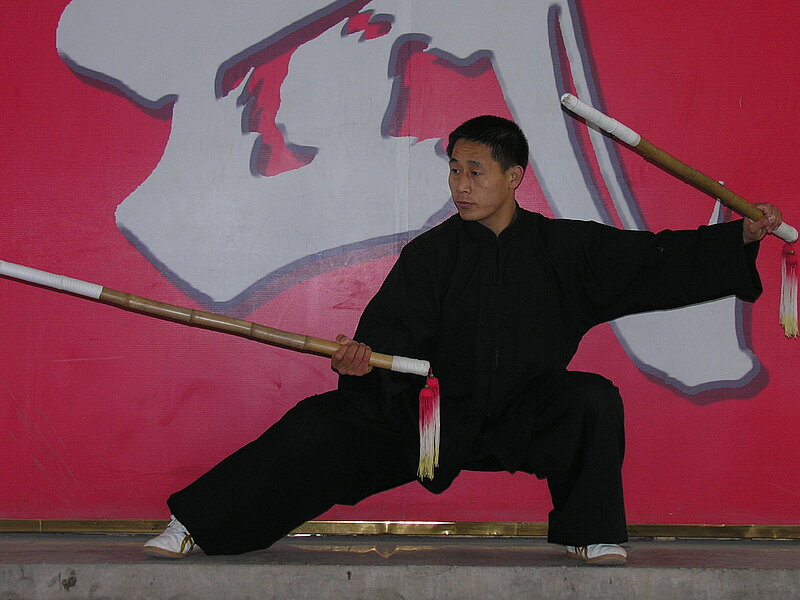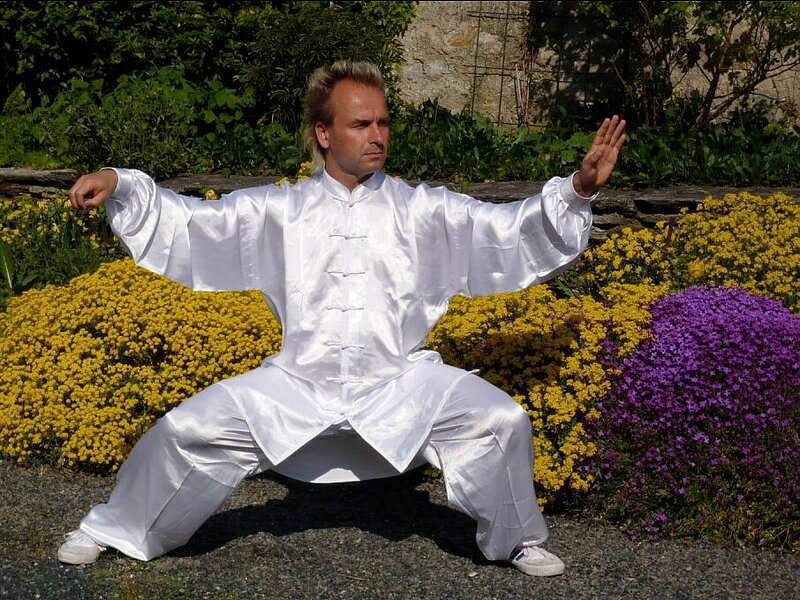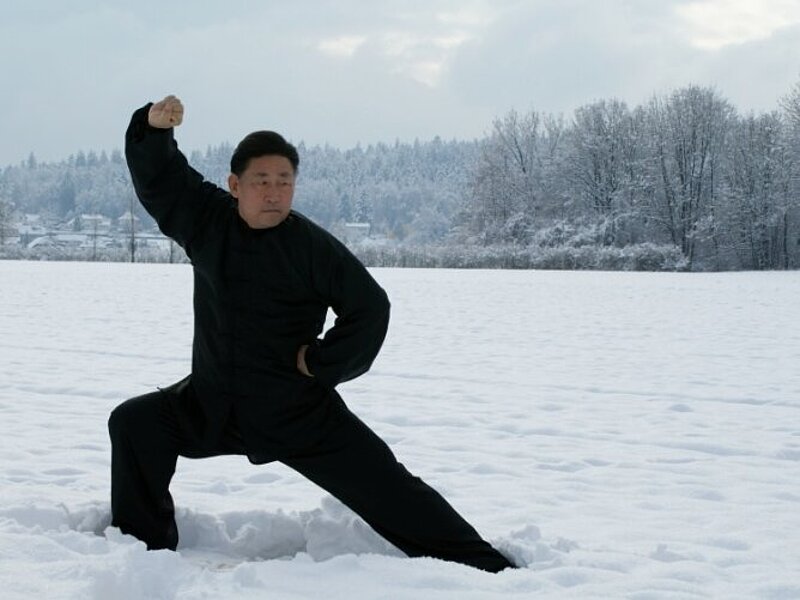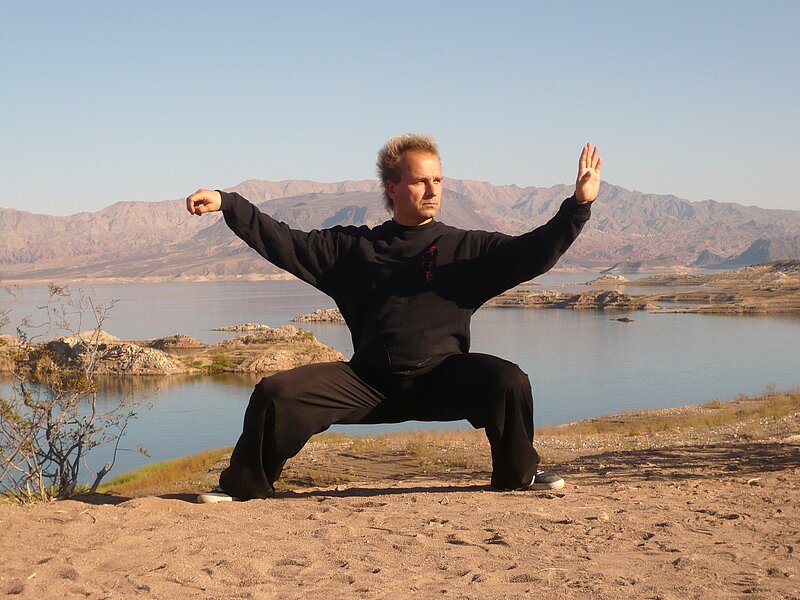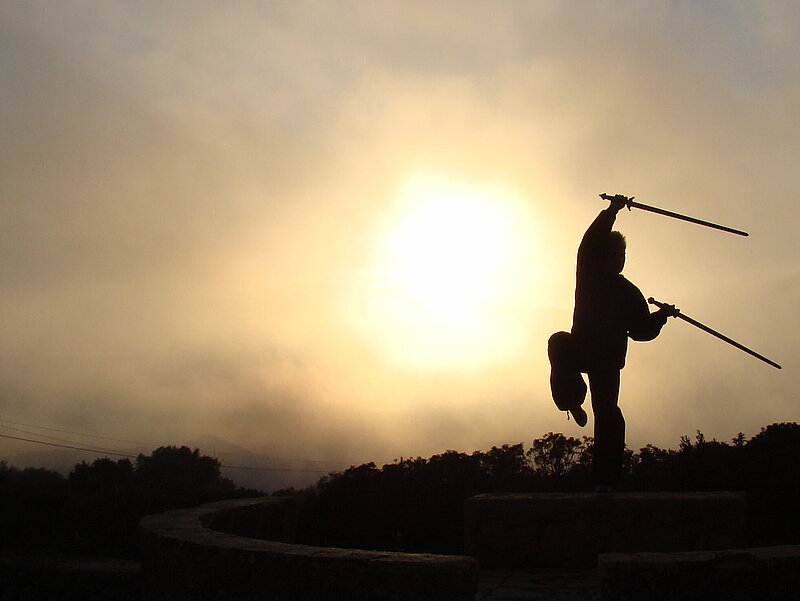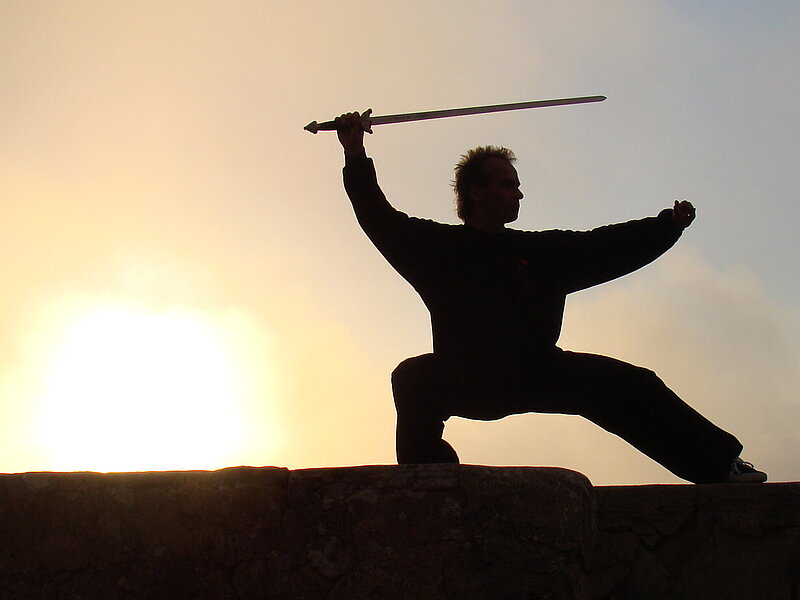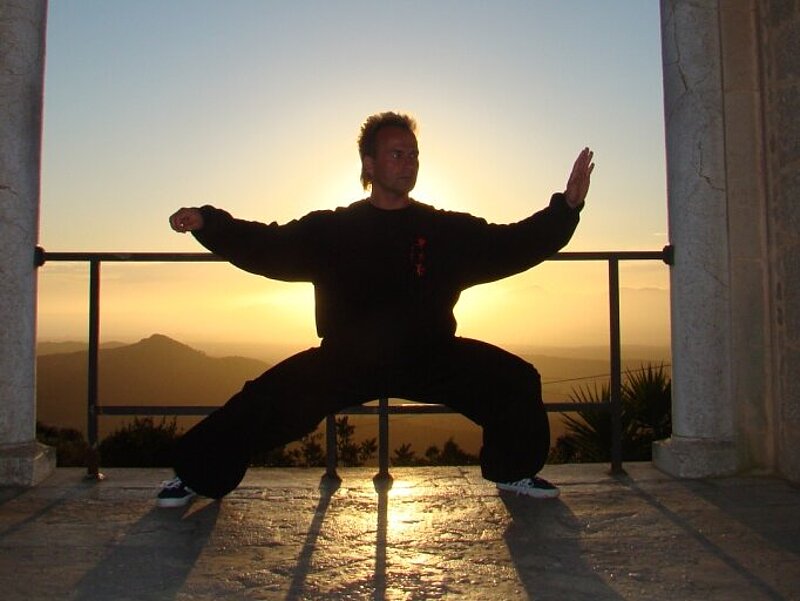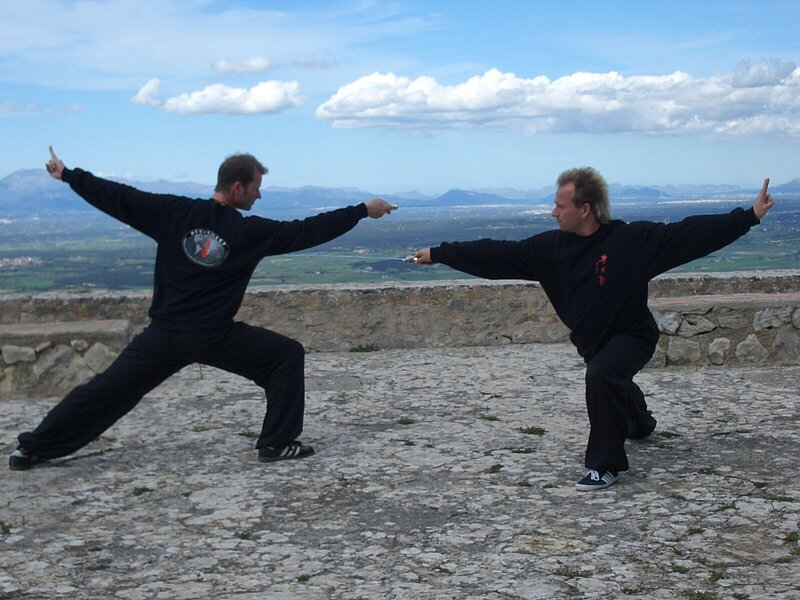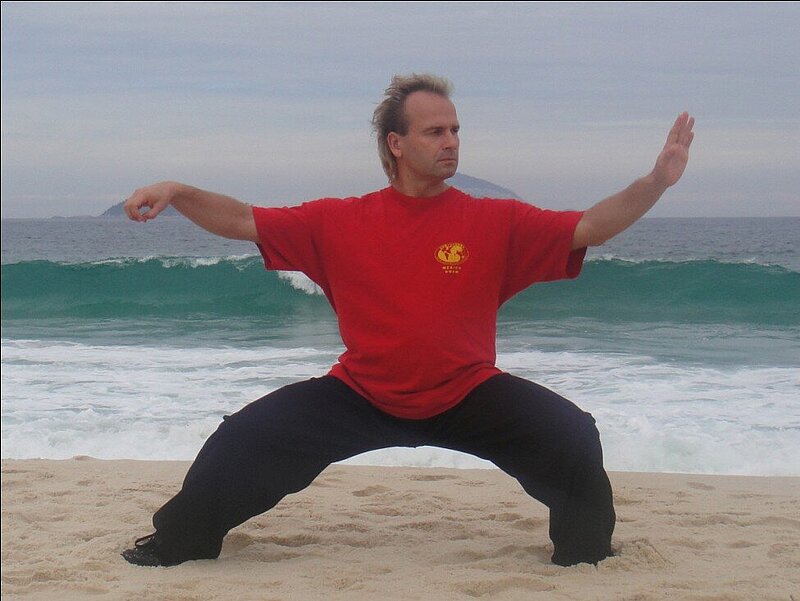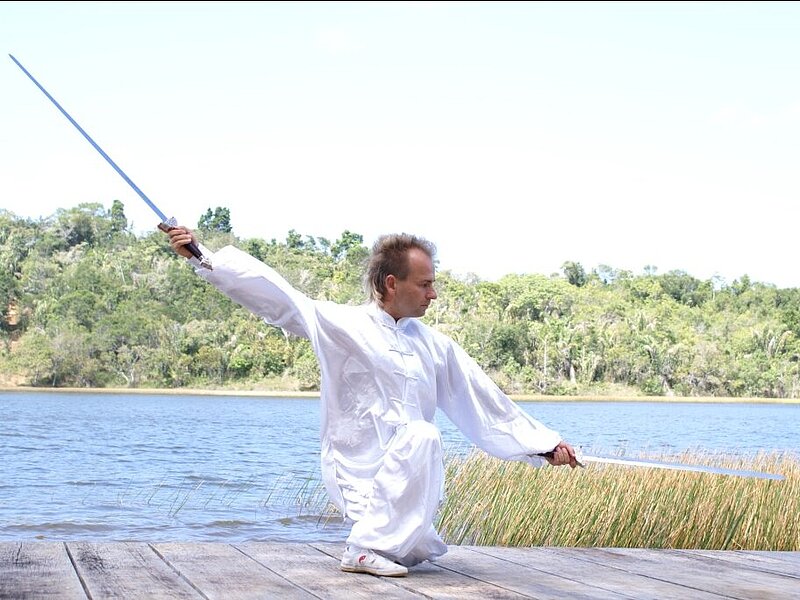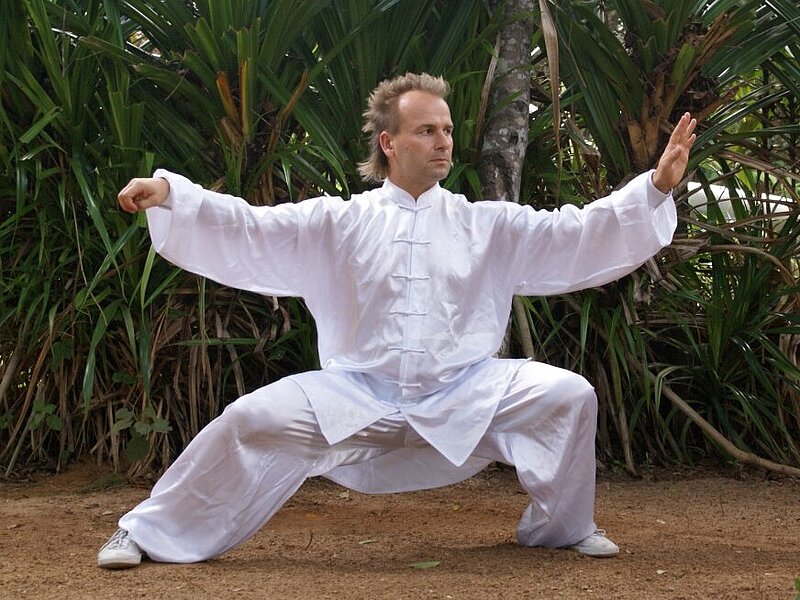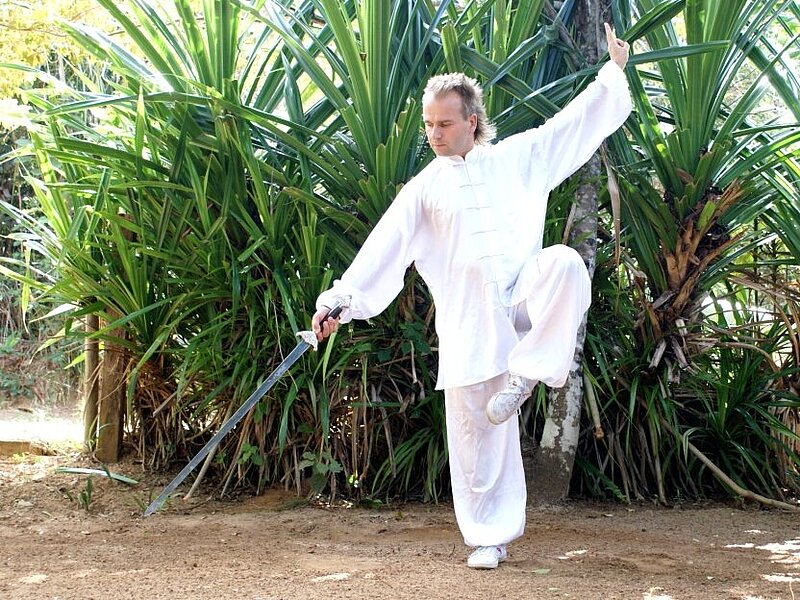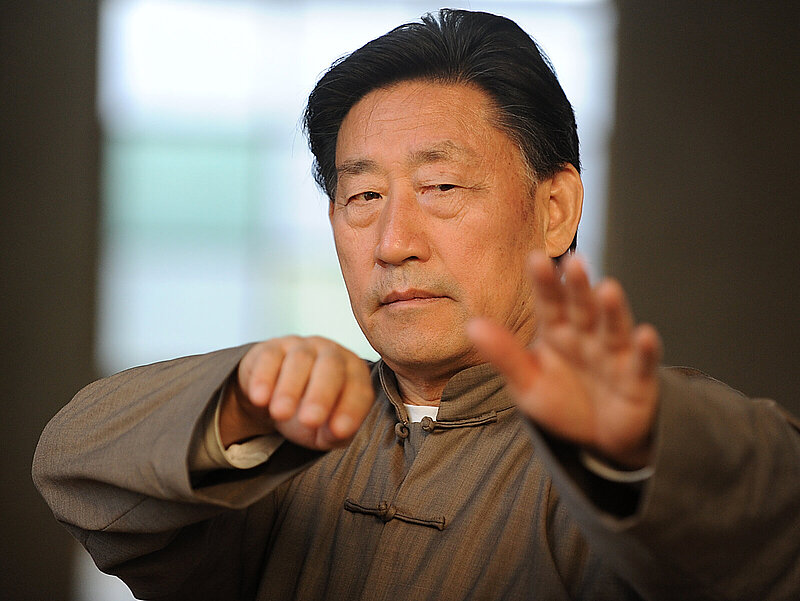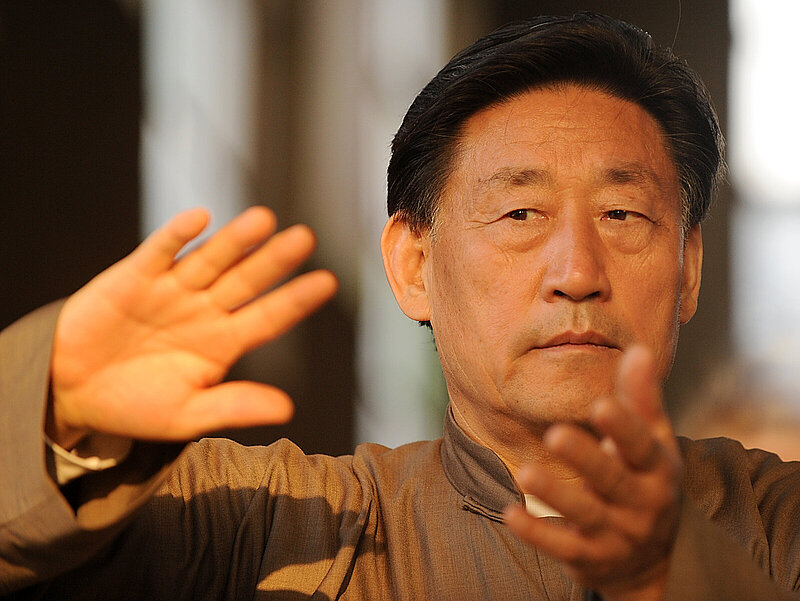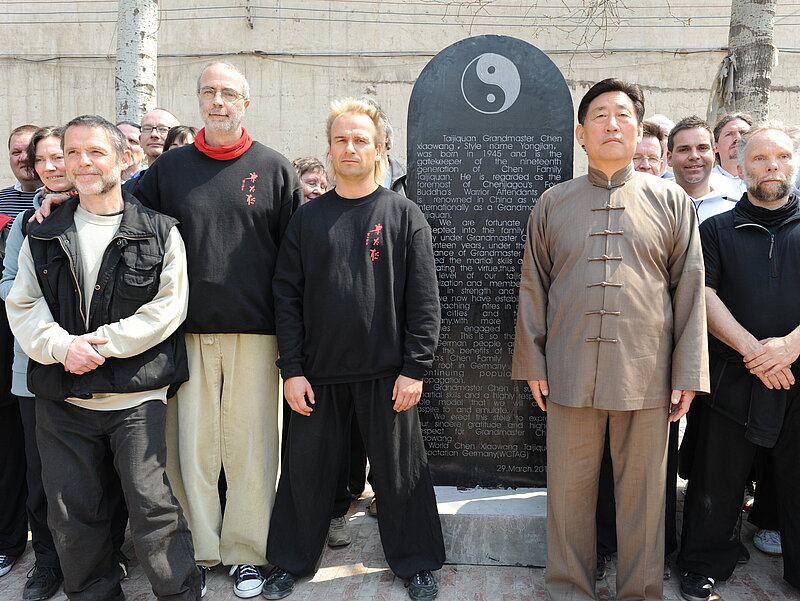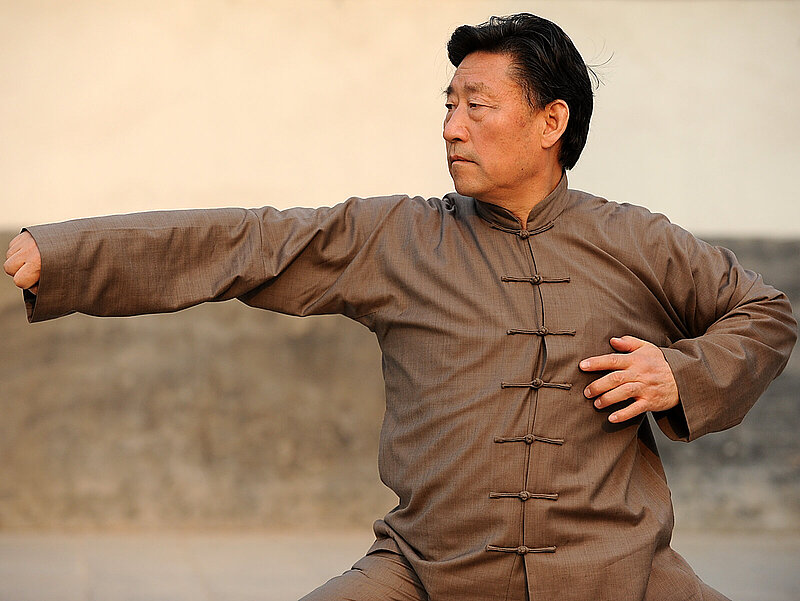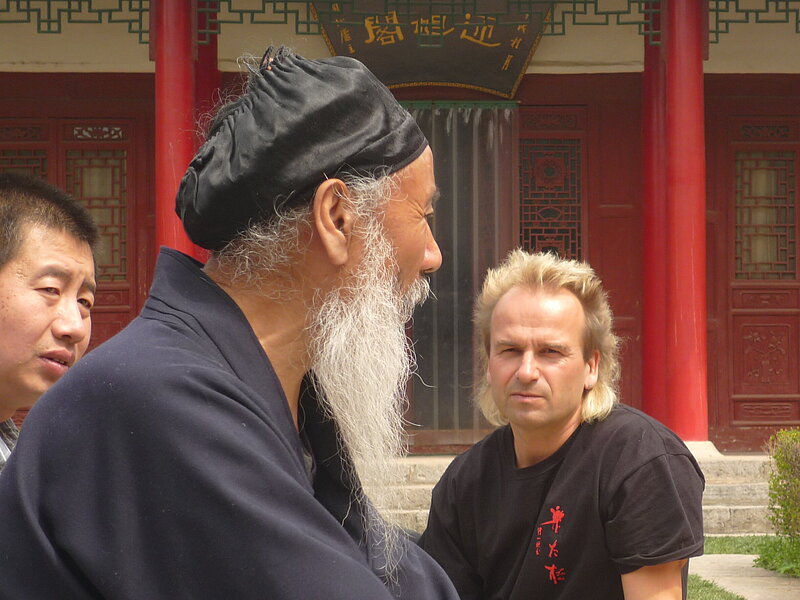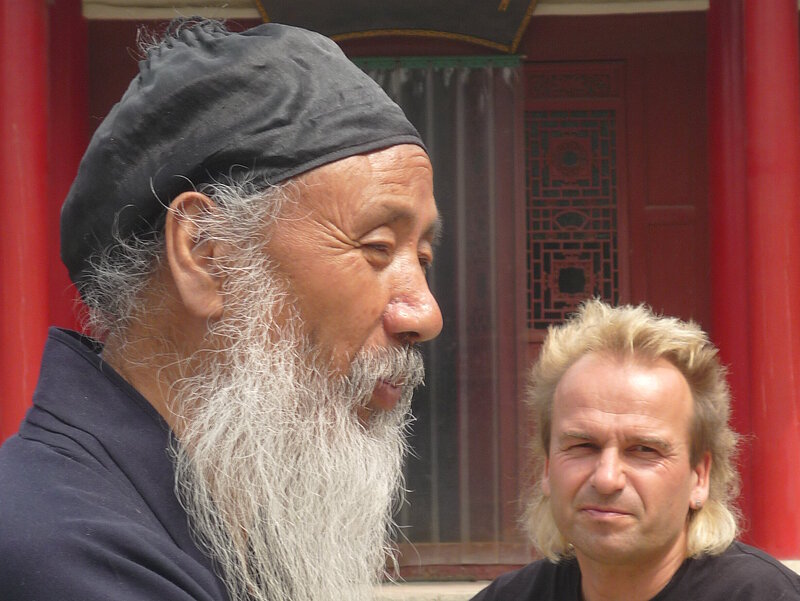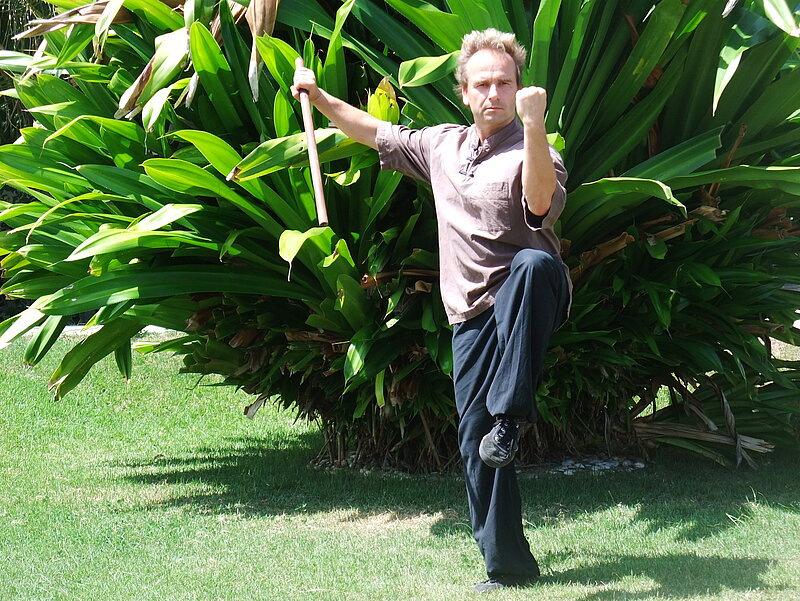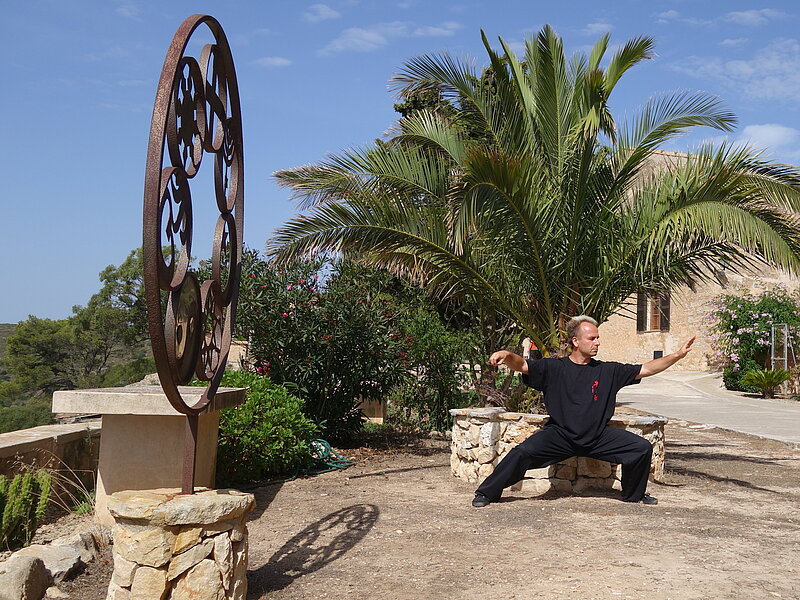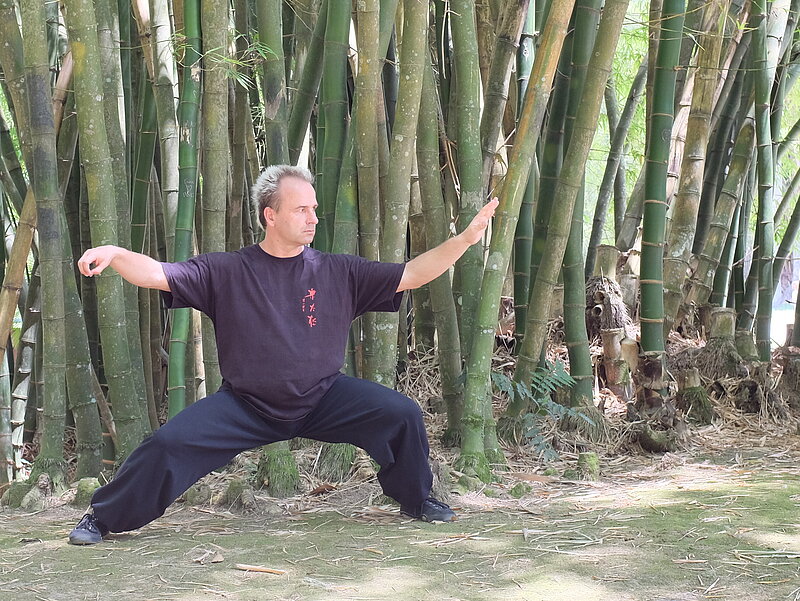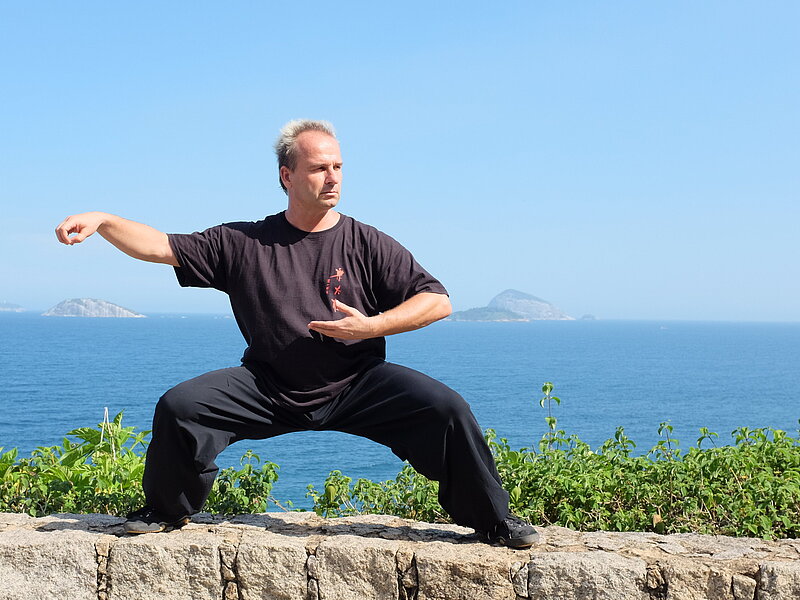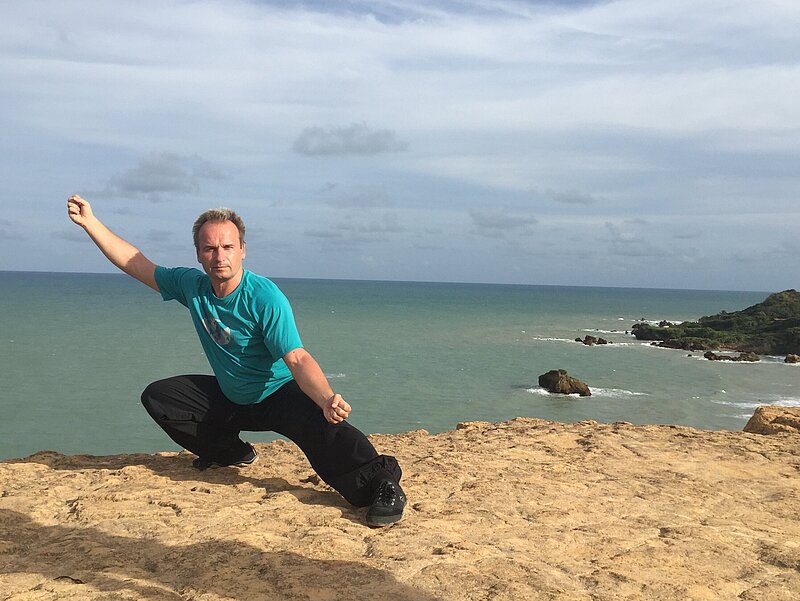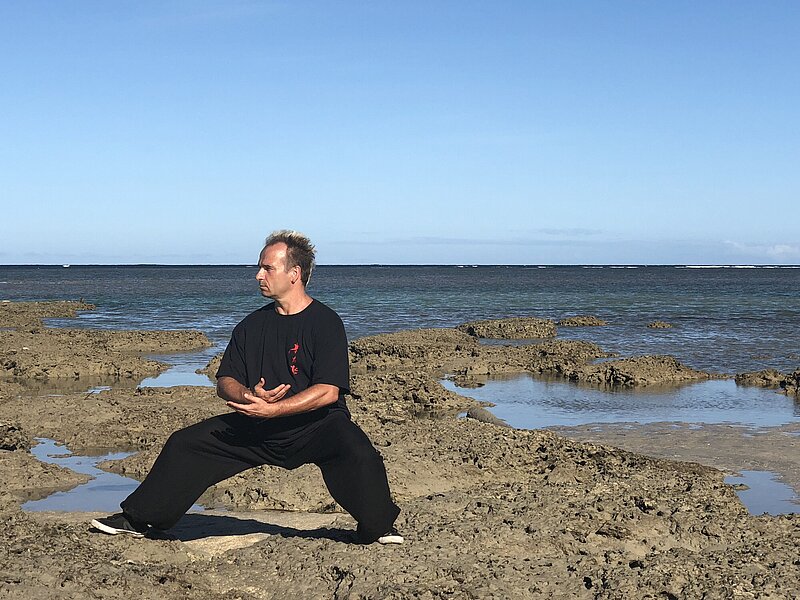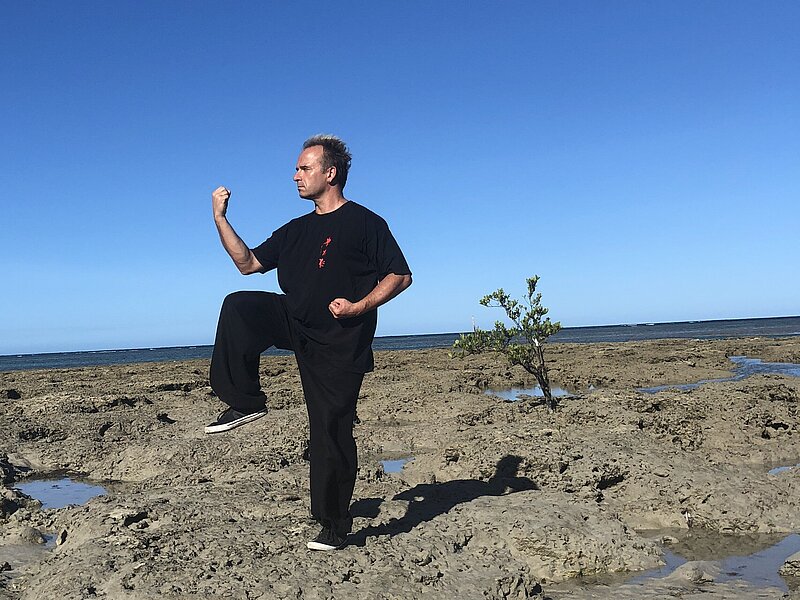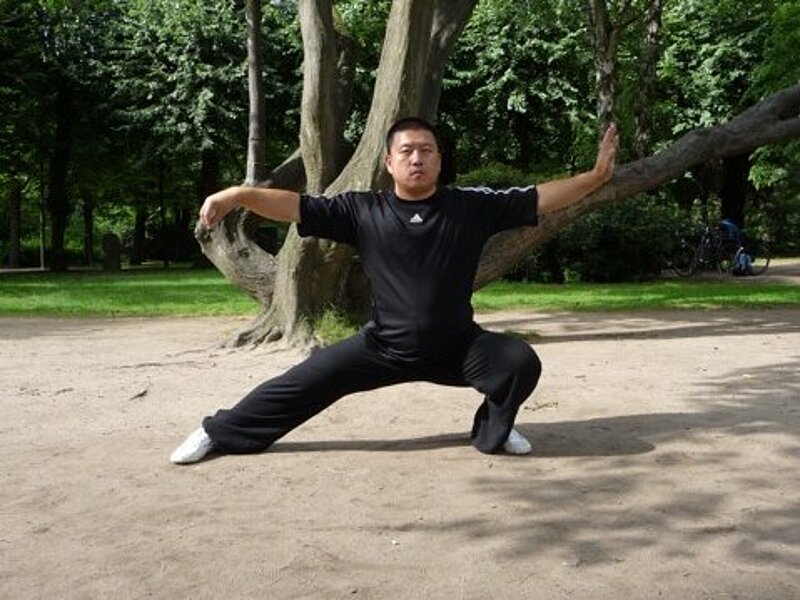Das Daodejing des Laozi im Taijiquan

Taijiquan ist eine über die Jahrhunderte gereifte chinesische Kampf- und Gesundheitskunst mit hohem philosophischen und spirituellen Inhalt. Sein Prinzip ist, wie könnte es anders sein, das Taiji-Prinzip. Das Taiji-Prinzip wiederum ist das Zusammenspiel von Yin und Yang. Und auch wenn die Begriffe Yin und Yang nur ein einziges Mal in ihm vorkommen, so ist das Daodejing doch der geistige Vater des Taijiquan. Denn gerade in diesem Werk finden wir all die Grundlinien gezeichnet, die später den Daoismus und unter anderem das Taijiquan in China hervorrufen sollten.
Innerhalb des religiösen Daoismus, welcher von Zhang Daoling aufgrund einer Vision des Laozi ab 142 n. Chr. begründet wurde, bewegte sich dann auch die Heilige Wei Huacun (252 – 334). Sie beeinflusste mit ihrem hinterlassenen Werk Huangtingjing den im 17. Jahrhundert lebenden General Chen Wangting maßgeblich dabei, das zu begründen, was wir heute Taijiquan nennen.
Daher ist es klar, dass das Daodejing nicht nur ein unschätzbar wertvolles Weisheitsbuch ist, welches neben der Bibel zu Recht das meist übersetzte Buch der Welt ist, sondern es müsste uns Taijiquan-Praktizierenden auch eine Fülle von umsetzbaren praktischen Hinweisen zu den geistigen Komponenten bereitstellen. Doch warum erscheint uns westlichen Lesern das Daodejing zwar artverwandt und philosophisch dem Taijiquan nahe, praktisch aber erkennen wir keine direkten Trainingshinweise, abgesehen von ein paar Überschriften?
Der Grund dafür liegt in der Tatsache, dass wir in der Regel nicht die Möglichkeit haben, uns eingehend mit dem Original und mehr noch mit den ursprünglichen Zeichen und ihren damaligen Bedeutungen auseinanderzusetzen. Tun wir dies jedoch, so werden wir feststellen, dass nicht nur das chinesische Original als solches uns unermesslich wertvolle Hinweise für unser Training liefert. Sondern gerade auch die Unterbedeutungen innerhalb der einzelnen Schriftzeichen, die Radikale, aus denen das jeweilige Zeichen zusammengesetzt ist, liefern uns äußerst tiefgreifende Anleitungen. Als kleiner Einstieg soll uns bereits das allererste Schriftzeichen Dào 道 dienen.
Während der Laie im Wörterbuch die Bedeutungen »Weg, Prinzip, Methode, Wahrheit etc.« finden kann, bleibt es dem geübten Zeichenbetrachter vorbehalten, hierin bereits eine Landkarte innerer Transformation und somit eine Anweisung für unsere Praxis zu erkennen. Denn wir entdecken im Zeichen Dào neben den Radikalen 185 für »Kopf«, shǒu 首, und 162 für »gehen, Füße beziehungsweise Weg«, chùo 辶, nach daoistischer Sichtweise auch zwei Augen 丷, die auf einen horizontalen Strich 一 schauen. Dieser Strich bedeutet im Chinesischen die Zahl Eins, Yi. Darunter finden wir das Zeichen für »selbst«, zì 自, und links daneben eben das Symbol, das für Füße, beziehungsweise einen zurückzulegenden Weg gilt: chùo. Zusammengenommen bedeutet dies nicht nur, der Weg ist das Ziel (der Kopf, dessen Augen dorthin schauen, wo der Geist schon angekommen ist, der Weg uns aber erst noch führt), sondern auch:
Zu schauen auf die Einheit, welche in uns selbst zu finden ist, ist der Weg, das Dao zu erreichen. Unser Training muss also die Innenschau und das Entwickeln unserer inneren Kräfte beinhalten. Von hier aus haben wir unseren Weg zu starten, um schließlich durch unsere Praxis im »Höchsten Letzten«, Taìjí 太極, anzukommen.
Schauen wir uns zum Beispiel gleich im ersten Vers die Zeilen an:
無名天地之始. 有名萬物之母.
»Nichtsein« nenne ich den Anfang von Himmel und Erde.
»Sein« nenne ich die Mutter der Einzelwesen.
Wir erkennen hier einen Punkt, an dem das »Nichtsein« ins »Sein« übergeht. Sprich es gibt einen Moment, den beide insofern miteinander teilen, als dass dieser das Tor zwischen beiden darstellt. »Anfang« Shǐ 始 und »Mutter« Mǔ 母 bezeichnen beide einen Moment des Beginns. Das erstere ist der Anfang des »Seienden« Yǒu 有, das Folgende die »Geburtsstunde« der materiellen Dinge und Wesen Wànwù 萬物.
Shi zeigt links das Radikal 38, nǚ 女, eine kniende oder stehende Frau mit Brüsten beziehungsweise – wie ich an der Uni gelernt habe – ein weibliches Geschlechtsorgan und daneben rechts oben das Radikal 28, sī 厶, unter anderem »privat, geheim, Tor« und darunter Radikal 30, kǒu 口, »Mund, Öffnung«, zusammen tái 台, etymologisch »sprechen (hier: schreien)«. Sprich wir haben dreifach die Bedeutung eines Tores, aus dem etwas »Geheimes«, sprich Verborgenes/vorher nicht Sichtbares nach außen dringt. Bildlich wie ein Kind, das man im Mutterbauch nicht sehen kann und das nun hervortritt (und dem Zeichen nach »schreit«). Hier also in dem Sinne »Anfang«, dass etwas noch nicht Erschienenes, also das Nichts, wú 無, in Erscheinung tritt.
Dieses in Erscheinung getretene Nichts nennt Laozi »Himmel und Erde« (tīandì 天地). Es sind die beiden polaren Urkräfte Yīn und Yáng. Wenn diese Urkräfte nun miteinander interagieren, werden hieraus die 10.000 Dinge/Wesen (Wànwù) gezeugt: Mǔ 母, »Mutter«, zeigt wieder nǚ 女, nun aber mit zwei Punkten, die die (stillenden) Brustwarzen einer Frau symbolisieren. Sprich »Mutter« steht auch hier für Anfang, bezeichnet aber nicht nur den Moment des Gebärens, sondern gleichwohl den des Nährens. Sprich den Beginn von etwas, was gerade erscheint und in den Moment des (Genährt-)Werdens übergeht. Daher erkennen wir zwischen shǐ 始 und mǔ 母 eine Bedeutungsnähe und Schnittmenge, gleichzeitig aber auch einen zeitlichen Verlauf, der in diesem Zusammenhang die Entstehung des Seins (yǒu 有) aus dem Nichts (Anfang) und dann das Sein in seiner materialisierenden und nährenden Funktion (Mutter) der 10.000 Dinge/Wesen beschreibt. Also die Abfolge Wǔ – Yǒu – Wànwù: Nichtsein – Sein– Dinge/Wesen.
Der konzentrierte Leser mag erkennen, dass der Zustand des reinen Seins also ein Nicht-Moment in dem Sinne ist, als dass im selben Moment bereits etwas aus dem Sein in Erscheinung tritt. Es ist daher das ewige reine Bewusstsein beziehungsweise das Tor zwischen dem Nichts und Raum und Zeit. Daher ist das reine Sein immer noch ein Nichts, aus dem im sofortigen, sogar selbigen Moment aber »ist« (sprachlich korrekt: sein wird). Sprich ein Moment, der noch nicht ist, in dem aber nicht mehr verhindert werden kann, dass er (und mit ihm alles darin) sein wird:
In dem Bereich des reinen Seins, wo zwar noch nichts Manifestiertes ist, aus dem aber alles manifestiert Existierende hervorgeht, erkennen wir den wahren und ursprünglichen Beginn: Den Moment wo noch nichts ist, aber nichts mehr »dagegen unternommen« werden kann, dass im allernächsten und scheinbar selben Moment »sein« wird. Dieser Moment des Seins, zwischen dem Nichts und der Erscheinung, wird ursprünglich mit Taiji bezeichnet. Es ist daher nicht verwunderlich, dass es Zeiten gab, in denen der Begriff Taìjí auch für einen höchsten und im wahrsten Sinne des Wortes grundlegenden Gott verwandt wurde. So wie dieser Moment also den allerersten Moment der Entstehung des Universums beschreibt, genauso erfahren wir ihn in jedem einzelnen Moment unseres Lebens. Pausenlos befinden wir uns in der Situation, auf einen vorhergegangenen Impuls reagieren zu wollen.
Und immer ist da der Moment, in dem noch keine Aktion stattgefunden hat, aber nichts mehr unternommen werden kann, dass sie nicht stattfindet. Vereinfacht ausgedrückt: Da ist der Beschluss, etwas tun zu wollen, und diesem Entschluss (auf welcher Ebene auch immer er gefasst wurde) folgt dann die Handlung. Bei also sehr subtiler Betrachtung entdecken wir den Moment, wo der Entschluss nicht mehr rückgängig gemacht werden kann, die Handlung aber noch nicht stattgefunden hat – jedoch unabdingbar stattfinden wird. Also genau der Moment des absoluten Anfangs einer jeden Bewegung, eines jeden Gedankens, einer jeden Reaktion usw. Wir befinden uns hier demnach in dem Moment, wo noch nichts ist, aber unabdingbar im nächsten Moment etwas sein wird. Wenn wir nun als Kampfkünstler einen Angriff vereiteln wollen, so ist es ratsam, dies so früh wie möglich zu tun. Im Ansatz, da sich hier seine Kraft noch nicht entfaltet hat. In der Regel geschieht dies durch Wachsamkeit und Schnelligkeit. Dies ist auch im Taijiquan so. Aber in der Praxis wird diese Fähigkeit nicht durch Schnelligkeitstraining, sondern genau umgekehrt: durch die verlangsamte Bewegung erreicht. Denn durch diese ist es möglich, immer näher an genau diesen ganz ursprünglichen Moment heranfühlen zu können. Und wenn ich zunehmend in der Lage bin, diesen bei mir selbst wahrzunehmen, werde ich auch, unterstützt durch mein Schiebende-Hände-Training, in der Lage sein, diesen beim Gegenüber zu erkennen. Da dies ohne Schulung prinzipiell nicht möglich ist, bringt mich dies wiederum in die Lage, die Bewegung des anderen wahrnehmen zu können, noch bevor sich mein Gegenüber selbst darüber bewusst wird. Dadurch kann ich ihm zuvorkommen.
Zuvorkommen bedeutet, seine Bewegung zu kontern, nachdem sie unwiederbringlich ausgeübt werden wird, jedoch noch bevor es tatsächlich zu einer äußeren Bewegung gekommen ist. Vereinfacht und wortwörtlich ausgedrückt: im allerersten Ansatz. Der jedoch ist so »allererst«, dass nur das intuitiv geschulte Wahrnehmen und der ungehinderte eigene Bewegungsansatz in der Lage sind, diesen Prozess wahrzunehmen und darauf im selben Nicht-Moment bereits adäquat (re-)agiert zu haben beziehungsweise besser: mitgeflossen zu sein.
So erklärt sich der klassische Satz: »Der Gegner bewegt sich nicht, ich bewege mich nicht. Der Gegner bewegt sich, ich bin schon da.« Jedoch keine Sorge, da auch meine Bewegung Zeit braucht, endet sie wie gesagt im Ansatz der Bewegung des anderen. Sprich ich beginne zwar, wo scheinbar noch nichts sichtbar ist, ende aber im Sichtbaren, also in der Bewegung des anderen. Ich starte daher nach wie vor als Zweiter, komme aber als Erster an.
Hierdurch erreiche ich eine Kampfkunst, die komplett defensiv ist, da sie sich niemals ohne vorangegangenen Angriff entfalten kann – hierin aber die effektivste Offensive übernimmt. Denn immer dort, wo der andere sich bewegen will, sind wir schon vor ihm da. Auch wenn wir erst (wenn auch äußerst kurz) nach ihm gestartet sind!
Was bedeutet dies für unser Formtraining? Gehen wir von der Vorbereitungsstellung aus. Die Füße sind schulterbreit auseinander, wir korrigieren unsere Haltung, kommen zur Ruhe. Aus uns maximal möglicher Geistesruhe beginnen wir uns nun zu bewegen. Aber wie geschieht dies? Genau hier erkennen wir den oben beschriebenen Zusammenhang: Es gibt einen Anfang, einen Moment, in dem ich beschlossen habe, die Bewegung zu machen. Aber nicht in dem Sinne, wie ich mir vornehme, nach Silvester nicht mehr zu rauchen. Sondern ganz konkret und unmittelbar. Sprich der innerste Moment, wo der »Bewegungsbefehl« bereits unwiderruflich auf den Weg gebracht ist, eine Bewegung aber auch in ihrem Ansatz noch nicht stattgefunden hat, jedoch nicht mehr widerrufen werden kann.
Dann, im unmittelbar nächsten Moment beginnt die Bewegung. Wir heben die Arme. Die erste Taiji- Figur entsteht. Abgesehen davon, dass wir natürlich in der Vorbereitungsstellung atmen, unser Herz schlägt, Blut fließt und so weiter, wir also fern von einem Zustand des Nichtseins wären, so haben wir doch, gerade auch durch unsere immer weiter verfeinerte Körperzentrierung und den immer tiefer zur Ruhe kommenden Geist eine Anlehnung an den Zustand, den wir »Wújí 無極« nennen. Aus diesem Zustand nun beginnt Taìjí, Yīn-Yáng, indem aus dem Nichts (Wú 無) Bewegung entsteht. Die Bewegung bringt nun alles ins Erscheinen und Manifeste.
Aus dem Nichtsein entsteht das Sein und dieses Sein schöpft/nährt das Manifeste (»Einzelwesen«). Aus dem »Nichtsein« entstehen (immateriell) »Himmel und Erde«. Diese schaffen in ihrer Vereinigung alle (materiellen) »Einzelwesen«. Der Himmel schöpft sie, die Erde nährt sie.
Nun dürfen wir hier jedoch nicht stehen bleiben und glauben, diesen Zustand des Urbeginns hätten wir nur beim Übergang zwischen der Vorbereitungsstellung und der ersten Formfigur. Wir müssen erkennen, dass wir diesen Moment in jedem neuen Bewegungsansatz haben. Sprich wenn die Arme auf Schulterhöhe angelangt sind und wir sie wieder senken wollen, werden wir mit genügend Aufmerksamkeit denselben Moment erleben. Dasselbe danach, wenn die Hüftdrehung einsetzt und so weiter. Bei weiterer Beobachtung stellen wir dann fest, dass dieser Bewegungsansatz nicht ab und an mal, wenn wir quasi »abbiegen«, eine neue Entscheidung fällen müssen, entsteht. Sondern er ist in jedem einzelnen Moment bis hin zu seiner kleinsten Einheit enthalten. Jede auch noch so kleine Bewegung hat diesen Impuls und diesen Anfang vorweg. So entsteht also jede noch so kleine Mikrobewegung aus dem Nichts (Wú), hat diesen unwiderruflichen Anfang (Taìjí/Yǒu) und kommt so ins manifestierte Sein (Wànwù).
Wenn wir, ohne dabei den daraus entstehenden Fluss zu vernachlässigen, die ganze Form über diesen Prozess aufmerksam beobachten können, wird uns klar, dass dies generell in unserem Leben immer und überall der Fall ist. Jeder Gedanke, jede Handlung, jedes Ereignis hat seine Ursache in etwas Vorhergehendem, braucht aber jeweils diesen einen Moment, wo es noch nicht ist, aber unbedingt im nächsten Moment sein wird.
So können wir uns durch die Erfahrung aus unserem Formtraining nicht nur besser vor Belästigungen schützen, sondern wir begreifen auch, dass, wenn wir von Geburt und Tod sprechen wollen, wir alles in einem viel größeren (eigentlich kleineren) Zusammenhang sehen müssen: Jedes einzelne Ereignis in meinem Leben, alles was ich tue und denke, wird in diesem beschriebenen Moment geboren und vergeht im gleichen Moment auch wieder, da die vollzogene Handlung (auch im allerkleinsten) in dem Moment, wo sie geschieht, gleichsam stirbt und nicht wiederholbar, sprich wiederzuholen ist. Geburt und Tod begegnen sich stets im selben Moment und liegen daher auf ein und demselben Punkt.
Dennoch aber erleben wir ein Kontinuum unseres Seins. Es gibt also ein Kontinuum, sprich Zeit, und es gibt einen Raum, in dem es stattfindet. Daher ist es aber (auch ohne eine mystische Erfahrung gemacht zu haben) unlogisch, wenn sich dieses Kontinuum gerade nur auf unser jetziges Dasein beschränken würde. Denn wenn dieses Kontinuum sich nur auf meine physische Geburt und meinen physischen Tod beschränken würde, dann könnte der einzelne Gedanke, die einzelne Handlung ebenfalls »der Meinung sein«, kein Teil eines größeres Ganzen, sondern nur separat in diesem Hier und Jetzt für sich zu stehen. Dann jedoch gäbe es keinen Fluss. Dann gäbe es kein Prinzip von Ursache und Wirkung, sprich die eine Handlung stünde nicht in Bezug zur anderen und ein Sinn wäre nicht möglich. Zeit wäre nicht möglich, Raum wäre nicht möglich.
Sehen wir zum Beispiel Vers 4:
道沖而用之或不盈.
Der SINN (das DAO) ist immer strömend.
Aber er läuft in seinem Wirken doch nie über.
Wenn das Dao »immer strömend ist«, dann ist da Sinn. Denn es gibt eine Abfolge von Ereignissen. Sprich es gibt Entwicklung. Doch die Essenz dieses Flusses ist leer. Wir wissen das nicht nur aus der Religion, sondern inzwischen auch aus der Physik: Die Essenz einer jeden Erscheinung ist Leerheit. Aus dieser Leerheit kommt sie in Existenz und in dieser vergeht sie auch wieder. Oben haben wir gesehen, dass dies in jedem noch so kleinen Moment stattfindet. Eine einzelne Lebensspanne ist daher unendlich klein, doch durch den unaufhörlichen Fluss geht sie ewig weiter. Alle Vergangenheit, Gegenwart und Zukunft liegt in ein und demselben Punkt und doch werden sie als fließend in Zeit und Raum wahrgenommen. Denn die manifestierten Dinge und Wesen (Wànwù) spiegeln das Potenzial des Nichtseins (Wú). Oder umgekehrt: Dieses gesamte Potenzial, das in diesem einzigen, außer Zeit und Raum liegenden »Punkt« (der also nicht mal ein Punkt ist), sprich in diesem Nichts liegt, beziehungsweise Nichts ist, manifestiert sich durch und innerhalb des Seins in den »10.000 Dingen und Wesen« (»Einzelwesen«/ Wànwù), in der dadurch entstehenden Zeit und dem dadurch entstehenden Raum. Nichtsein und Sein beziehungsweise die daraus entstehenden Manifestationen sind also ihrer Natur nach gleich und »unterschieden nur im Namen«:
此兩者同出而異名
Beides ist eins dem Ursprung nachund nur verschieden durch den Namen. (Vers 1)
Auf welche Weise beide miteinander in Verbindung stehen, erkennen wir bereits in dem von Laozi verwandten Schriftzeichen für »strömen«, 沖, chōng, welches auch 冲 geschrieben werden kann. Wir sehen einen Kasten, wéi 囗, der eine »Umzäunung oder Begrenzung« beschreibt (auch kǒu, ›Mund‹), der genau in der Mitte mit einem vertikalen geraden Strich丨(shù, beziehungsweise als Radikal 2: gun/gǔn, »Stock«) durchzogen ist und damit die Mitte bezeichnet. Links daneben finden wir das Radikal 85, shǔi 氵, welches für »Wasser« steht. Das Wasser in der Mitte eines Flusses strömt.
Aber zu der oben beschriebenen Leerheit aller Phänomene erkennen wir bei genauer Betrachtung die Leerheit gerade auch durch den Fluss: Denn das Besondere an einem Fluss ist ja, dass er in keinem Moment so ist, wie er eben war. Er ist das Symbol der ständigen Veränderung. Da alles ständig am Fließen ist, ist nicht nur nichts so, wie es eben noch war, sondern es ist ebenfalls zu keinem Zeitpunkt je etwa greif- beziehungsweise festhaltbar. Sprich nichts in diesem Fluss besitzt Permanenz. Wenn ich mir den Fluss jetzt quasi unter dem Mikroskop anschaue, so erkenne ich zudem noch die ständige Wandlung und Veränderung auch jedes einzelnen seiner Bestandteile. Schaue ich mir dann die äußere Welt an, so erkenne ich, dass sich diese ständige Wandlung auch in den großen Gebilden, die sich aus den kleinen geformt haben, beständig fortsetzt. Daher können wir den Satz bestätigen: »Das einzig Beständige ist die Wandlung.«
Beide Phänomene, also im Großen wie im Kleinen, können nicht nur über den Verstand durchdacht, sondern auch durch vertiefte und subtile Meditation erfahren werden. Wenn daher weder im Großen noch im Kleinen etwas Greifbares oder Festhaltbares ist, so können wir sagen, dass da im Endeffekt nichts (Permanentes) ist. Denn wir können nichts Festes, keinen festen Punkt definieren. So können wir auch unser Leben nicht auf- oder festhalten, ein Moment reiht sich an den anderen und wir sind Teil dieses Flusses, erleben Ereignis nach Ereignis, haben dadurch einen Sinn und dennoch ist alles gleichzeitig leer (nicht permanent). Wie könnte man dies besser beobachten und untersuchen, aber gleichzeitig auch spüren, erfahren und erleben, als in unserer Taiji-Form. Wir beobachten, wie sich unaufhörlich Bewegung aneinanderreiht.
Dies mag zunächst mehr symbolisch erscheinen, denn wir könnten mit der Bewegung ja aufhören. Aber hört Bewegung dadurch wirklich auf? Was ist mit unserer Atmung, mit unserem Herzschlag, mit der Blutzirkulation – hört die Welt auf sich zu drehen, weil wir scheinbar still halten, was wir zudem gar nicht können?
In dieser Beobachtung der dahinfließenden Formelemente also erkenne ich den unaufhaltsamen Fluss von Ereignis zu Ereignis. Ich kann den Moment nicht festhalten, ich kann ihn nur erleben. So spüre ich mit der Zeit eine Leerheit hierin, die allerdings in sich eine große Fülle trägt:
大盈若沖其用不窮.
Große Fülle muss wie strömend erscheinen, so wird sie unerschöpflich in ihrer Wirkung. (Vers 45)
Genauso ist es mit der (natürlich identischen) Leerheit, die ich quasi als Hintergrund hinter den Bewegungen ausmache, sprich als das Parkett, auf dem sich die Wandlung abspielt. So erlebe ich in meiner Taiji-Form stets beides: Wuji und Taiji, Nichtsein und Sein, manifestiert in den 10.000 Dingen/Wesen, sprich Formen/Gestaltungen und Bewegungen, zu denen auch wir selbst gehören. Hier noch eine weitere schöne Erklärungsweise des Verhältnisses zwischen Nichtsein und Sein: Nehmen wir dazu die andere Schreibweise von chōng 沖: 冲, wo wir die drei Striche links als nur zwei wiederfinden. Hier haben wir links jetzt das Radikal 15, bīng 冫, welches für »Eis« steht. Huizhang Ren Farong erklärte es mir aus seiner daoistischen Sicht wie folgt: Wenn Du in den beiden Strichen Yin und Yang siehst, und diese zur Mitte kommen, also sich bis ins Letzte harmonisieren, dann lösen sich diese wie Teilchen und Antiteilchen ineinander wieder auf und bilden wieder die eine ursprüngliche Energie. So kommt die Leere wieder zum Vorschein (symbolisch das unbewegte Eis), in der potenziell das Alles ist – nicht manifestiert in der einen ursprünglichen Energie des Absoluten (Dao).
Auch diese Wahrheit können wir in unserem Formtraining entdecken und kultivieren, wenn wir die Bewegungen genau in ihrem Entstehen und Vergehen beobachten und gleichzeitig aber den Fluss nicht nur der einzelnen Figurensequenz zur nächsten, sondern jedes einzelnen Bewegungselementes zum nächsten hin nicht unterbrechen. Mit vertiefter Praxis erfahren wir dann die Leerheit als Grund und den daraus und auf diesem basierenden Fluss der Bewegung. Sprich Nichtsein und Sein in ein und demselben Moment, wie Leinwand und Film. Natürlich bedeutet dies zu Beginn des Trainings vorerst, dass wir überhaupt erst einmal die Figuren adäquat lernen müssen und dann ein Niveau von Bewegung erreichen können, dass sich alle Veränderungen geschmeidig ineinander fortpflanzen.
Am Anfang tun wir dies noch recht abgehackt und oberflächlich. Aber über die Jahre finden wir diesen Zusammenschluss fließender Energie bis in die kleinste Bewegungstendenz hinein und können so vom tiefsten Inneren bis hin in die äußerste Bewegung einen ununterbrochenen Fluss herstellen. Hierdurch harmonisieren wir Yin und Yang. Durch die Harmonisierung von Yin und Yang finden wir zur Ruhe. Durch mehr Ruhe können wir tiefer empfinden, wir können das »Flüstern« unseres Körpers hören. Dadurch können wir Yin und Yang nun auf tieferer Ebene harmonisieren. Dadurch verwandelt sich Ruhe in Stille. So können wir wieder tiefer wahrnehmen, noch tiefer gehend harmonisieren und gelangen von unserer geistigen Stille nun in eine geistige Leere, aufgrund derer wir wiederum die Leerheit der Bewegung erkennen können.
Durch den Fluss der Bewegung und gerade durch die immer subtilere Feinheit des immer ursprünglicheren Flusses bis hin zur Wahrnehmung seiner Leerheit können wir daher das gesamte Weltgesetz erkennen, das natürlich nicht nur hier, sondern in allen Ereignissen von Zeit und Raum basierend auf der Quelle des Nicht-Seienden beständig stattfindet.
Den kontinuierlichen Fluss des Lebens – aus seiner Quelle des Nichts heraus – wahrnehmen zu können, kann als höchstes Ziel spiritueller Entwicklung im Taiji-Formentraining bezeichnet werden.
Dass es »in seinem Wirken nie überläuft« kann uns ganz praktisch den Hinweis geben, mit unseren Taiji-Bewegungen im Rahmen ihrer Effizienz zu bleiben. Denn dieser Fluss ist ja gerade nur dann fühlbar, wenn die Bewegungen in ihrer richtigen Struktur und Zentriertheit ausgeführt werden. Ein jegliches Überlehnen (»Überlaufen«) ist immer ein Zuviel und hindert den Energiefluss in unserem Körper und damit auch seine Kraft und unsere Wahrnehmung dessen. Denn je freier die Energie Qi fließt, umso mächtiger ist sie, umso mehr Kraft steht zur Verfügung und umso einfacher ist es für uns, sie zu fühlen.
Diese Effizienz zeigt sich dann auch in der kämpferischen Auseinandersetzung, wenn es darum geht, Kraft übertragen beziehungsweise Kraft unverletzt aufnehmen zu wollen. Auch hier bildet das Zusammenspiel innerhalb der Einheit, jetzt im Sinne der körperlich/geistigen Zentriertheit, und des daraus entstehenden Dualismus, sprich der in Einheit stattfindenden Bewegung (Yin-Yang), die Grundlage jedes Könnens und jeder Erkenntnis. Höchste (auch kämpferische) Effizienz erhalte ich also durch fließende, ungehinderte Bewegung, in der die zentrierte Einheit nicht verlorengeht. Dies ist die wunderbare Verbindung und Abhängigkeit der Aspekte des »Waisanhe« und des »Neisanhe«: der drei äußeren und der drei inneren Verbindungen des Taijiquan.
Unser Training spiegelt also auf ganz wunderbare Weise den Prozess des Lebens, seiner Herkunft und seines Sinns/Dao. Und nicht nur das: Es lässt uns erahnen, wie auch unser unendlich ereignisreiches Leben wiederum nur als ein Ereignis in dem Kontinuum unendlich vieler vorheriger und weiterer Ereignisse steht.
Jan Silberstorff


